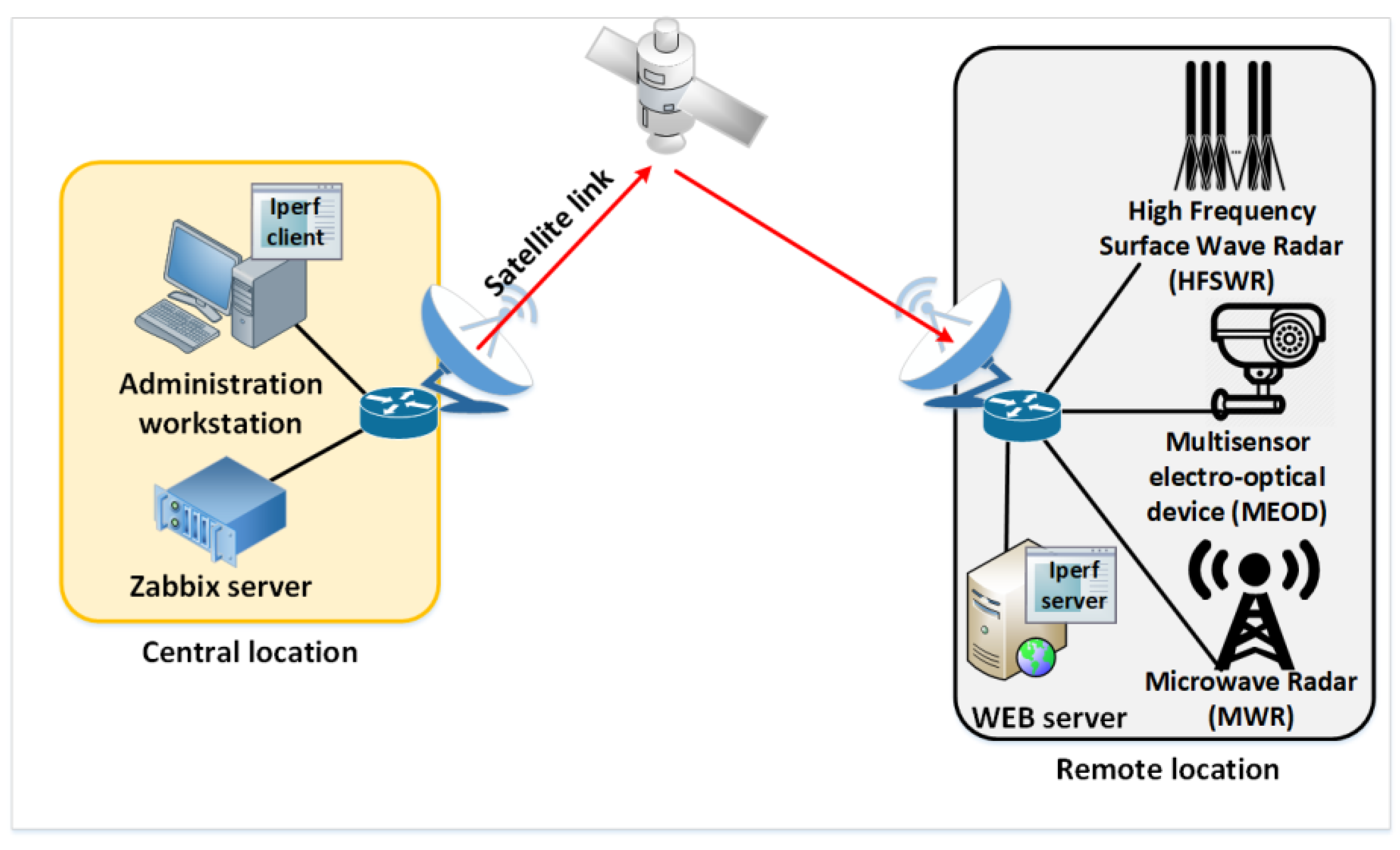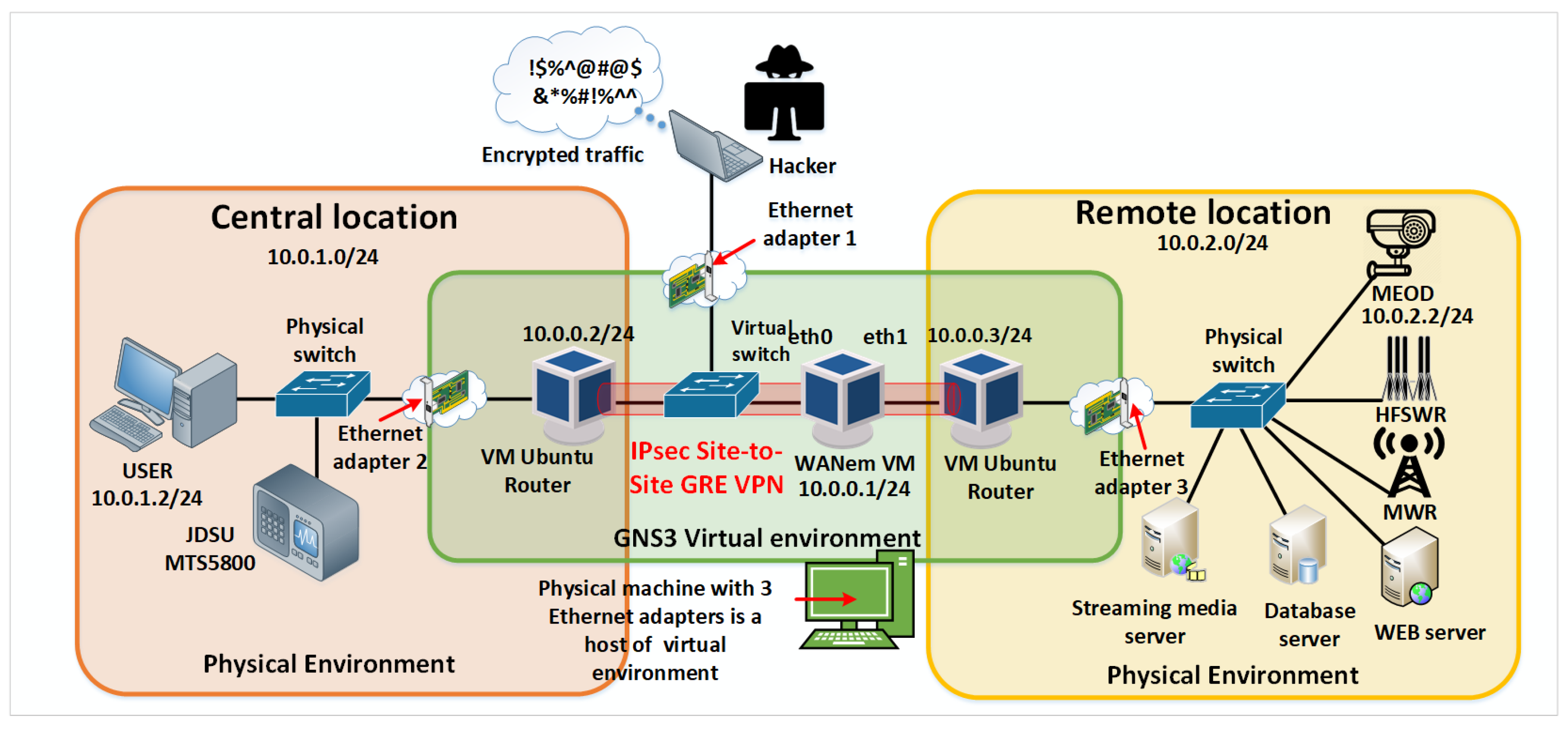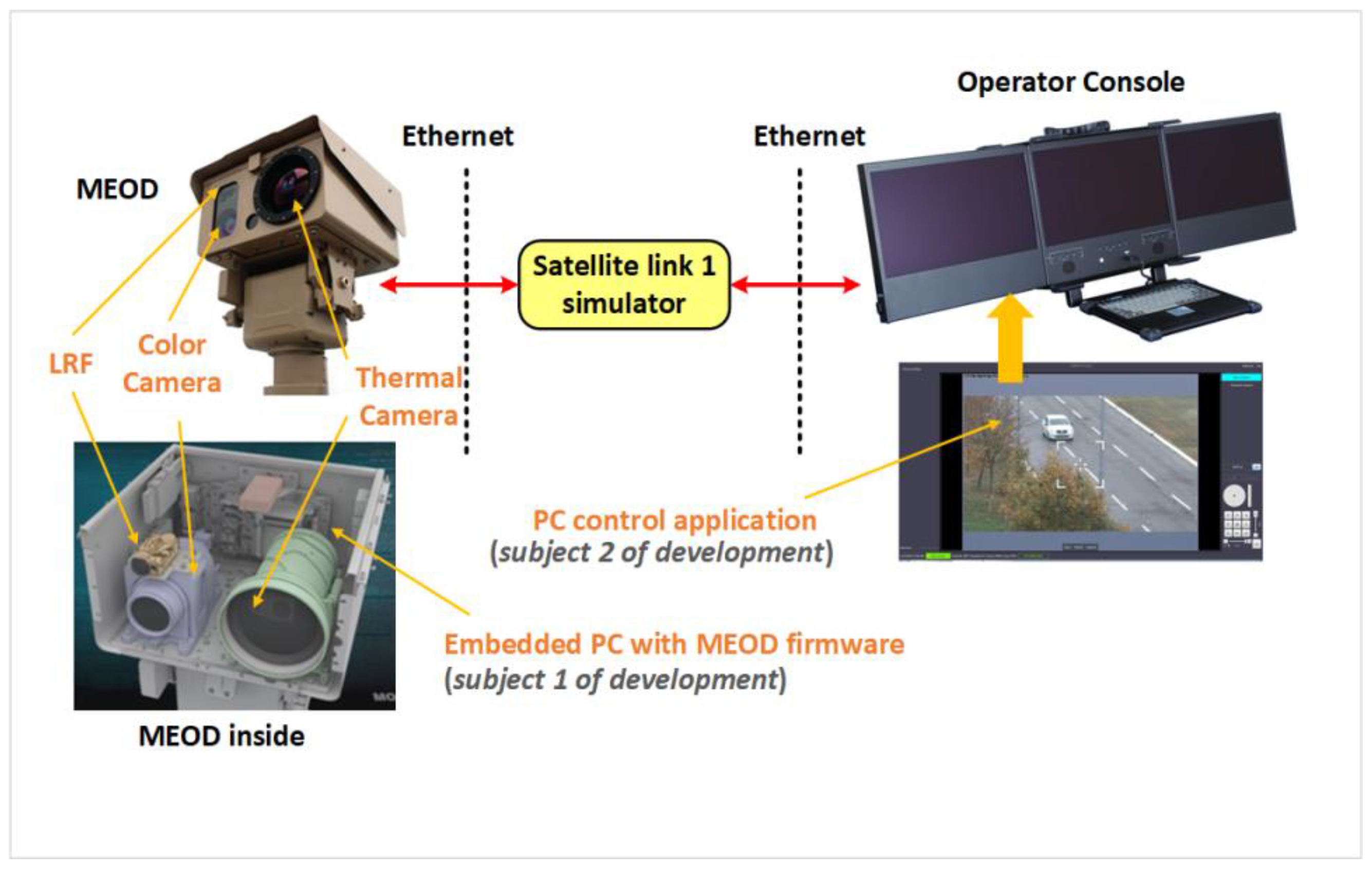Designing Laboratory for IoT Communication Infrastructure Environment for Remote Maritime Surveillance in Equatorial Areas Based on the Gulf of Guinea Field Experiences
Abstract
1. Introduction
2. The Deployed Sensor Network and Its Communication Infrastructure
- Two HFSWRs with a nominal range of 80 nautical miles (approx. 150 km) for Bonn express class of vessel [33] during night-time and sea states [34] up to 3. For larger vessels and during the day-time, the range can extend even beyond 125 nautical miles (approx. 230 km). Regardless of the time of day and vessel size, angle coverage is set to 120 degrees. HFSWR network coverage area currently covers the western part of the Gulf of Guinea as shown in Figure 1,
- There are also data provided from satellite AIS provider, but since the data are delivered directly to the main command and control center (i.e., that data are not transferred from remote locations) it will not be further examined here.
- Microwave radars and HFSWRs require a small amount of data, but all data need to be delivered in real-time,
- MEODs require a large amount of data in real-time,
- Although LRFs require a relatively small amount of data for measurement results, for measurement triggering accurate video image transmission with low latency is required. Thus, remote usage of LRF is the most demanding service regarding transmission network performance requirements in this network.
3. Determination of Existing Communication Infrastructure Parameters
3.1. Network Parameters
3.2. Estimation of Satellite Link Parameters
4. Realization of IoT Communication Infrastructure Environment
4.1. System Architecture and Configuration
4.2. Analyses of Eavesdropping in Satellite Link in the Proposed Laboratory
5. Use cases of the Proposed Laboratory for IoT Communication Infrastructure
- Packet error rate (PER) and
- Distribution that describes the duration of network outage
5.1. Use Case 1: HFSWR Data Fusion
5.2. Use Case 2: Remote Distance to Target Measurement Using LRF
- Live video streaming requires high bandwidth, which might be very expensive when using satellite link as transmission media
- Operator user experience requires the highest possible resolution and frame rate of video stream
- Targeting for distance measurement is performed by pan-tilt positioner, whose control should be smooth for a good user experience
- LRF can perform very limited measurement within a time frame (e.g., six measurements per minute) due to its construction, because the laser needs to be re-charged after measurement
- Usage of satellite link gives a huge delay which makes measuring triggering difficult for moving target
5.3. Potential Expansions of the Proposed Laboratory for IoT Communication Infrastructure Environment
6. Conclusions and Future Work
Author Contributions
Funding
Conflicts of Interest
References
- United Nations. Law of the Sea, Part V—Exclusive Economic Zone; United Nations: New York, NY, USA, 2011. [Google Scholar]
- United Nations. Law of the Sea, Part II—Exclusive Economic Zone; United Nations: New York, NY, USA, 2011. [Google Scholar]
- UN Security Council Urges ‘Comprehensive Response’ to Piracy Off Somali Coast. Available online: https://news.un.org/en/story/2017/11/570172-un-security-council-urges-comprehensive-response-piracy-somali-coast (accessed on 13 August 2019).
- Eunavfor Mission. Available online: http://eunavfor.eu/mission/ (accessed on 13 August 2019).
- Worldwildlife Overfishing. Available online: https://www.worldwildlife.org/threats/overfishing (accessed on 13 August 2019).
- Greenpeace. Available online: https://www.greenpeace.org.uk/what-we-do/oceans/overfishing/ (accessed on 13 August 2019).
- Leymarie, P.; Rekacewicz, P.; Stienne, A. UNOSAT Global Report on Maritime Piracy—A Geospatial Analysis 1995–2013; United Nations Institute for Training and Research (UNITAR): Geneva, Switzerland, 2014. [Google Scholar]
- Fabrizio, G.A. High Frequency Over-the-Horizon Radar: Fundamental Principles, Signal Processing, and Practical Applications; McGraw-Hill, Inc.: New York City, NY, USA, 2013; ISBN 978-038-723-190-7. [Google Scholar]
- Barca, P.; Maresca, S.; Grasso, R.; Bryan, K.; Horstmann, J. Maritime Surveillance with Multiple Over-the-Horizon HFSW Radars: An Overview of Recent Experimentation. IEEE Aerosp. Electron. Syst. Mag. 2015, 30, 4–18. [Google Scholar] [CrossRef]
- Nikolic, D.; Stojkovic, N.; Petrovic, P.; Tosic, N.; Lekic, N.; Stankovic, Z. The high frequency surface wave radar solution for vessel tracking beyond the horizon. Facta Univ. Electron. Energetics 2020, 33, 37–59. [Google Scholar] [CrossRef]
- Peric, D.; Livada, B.; Peric, M.; Vujic, S. Thermal imager range: Predictions, expectations, and reality. Sensors 2019, 19, 3313. [Google Scholar] [CrossRef]
- Livada, B.; Peric, D.; Peric, M. Challenges of Laser Range Finder Integration in Electro-Optical Surveillance System. In Proceedings of the 4th International conference on electrical, electronic, and computing engineering (IcETRAN 2017), Kladovo, Serbia, 5–6 June 2017. [Google Scholar]
- Iridium Satellite Communications Home Page. Available online: https://www.iridium.com/ (accessed on 10 September 2019).
- Inmarast Enabling the Connected World. Available online: https://www.inmarsat.com/ (accessed on 10 September 2019).
- Telesat Satellite Services. Available online: https://www.telesat.com/ (accessed on 10 September 2019).
- Friess, P.; Riemenschneider, R.; Vermesan, O.; Guillemin, P.; Serrano, M.; Bouraoui, M.; Freire, L.P.; Kallstenius, T.; Lam, K.; Eisenhauer, M.; et al. Digitising the Industry - Internet of Things Connecting the Physical, Digital and Virtual Worlds; Vermesan, O., Friess, P., Eds.; River Publisher: Aalborg, Denmark, 2016; Volume 49, ISBN 978-87-93379-82-4. [Google Scholar]
- Unleashing the Potential of the Internet of Things; International Telecommunication Union: Geneva, Switzerland, 2016.
- Kalitay, H.K.; Nambiar, M.K. Designing WANem: A Wide Area Network emulator tool. In Proceedings of the 3rd International Conference on Communication Systems and Networks (COMSNETS 2011), Bangalore, India, 4–8 January 2011. [Google Scholar]
- WANEM: The Wide Area Network Emulator—Source Forge. Available online: http://wanem.sourceforge.net/ (accessed on 1 August 2018).
- GNS3: The Official Guide And Reference for GNS3. Available online: https://docs.gns3.com/ (accessed on 15 September 2018).
- StrongSwan Home Page. Available online: https://www.strongswan.org/ (accessed on 15 September 2018).
- Quagga Software Routing Suite. Available online: https://www.quagga.net/ (accessed on 15 September 2018).
- Chappell, L. Troubleshooting with Wireshark - Locate the source of performance problems. In Wireshark Solution Series; Aragon, J., Ed.; Chappell University: San Jose, CA, USA, 2014; ISBN 978-1-893939-9-74. [Google Scholar]
- Vacche, A.D.; Lee, K.S. Zabbix Network Monitoring Essentials; Packt Publishing Ltd.: Birmingham, UK, 2015; ISBN 978-1-78439-976-4. [Google Scholar]
- iPerf—The ultimate speed test tool for TCP, UDP and SCTP. Available online: https://iperf.fr/ (accessed on 15 September 2019).
- Poongothai, M.; Subramanian, P.M.; Rajeswari, A. Design and implementation of IoT based smart laboratory. In Proceedings of the 5th International Conference on Industrial Engineering and Applications (ICIEA), Singapore, 26–28 April 2018; pp. 169–173. [Google Scholar]
- Tian, J.; Li, X.; Wan, D.; Li, N.; Wang, Y. Design of intelligent laboratory based on IOT. In Information Technology and Intelligent Transportation Systems. Advances in Intelligent Systems and Computing; Balas, V., Jain, L., Zhao, X., Eds.; Springer: Cham, Switzerland, 2016; Volume 454, pp. 687–692. ISBN 978-3-319-38787-1. [Google Scholar]
- Rout, K.K.; Mishra, S.; Routray, A. Development of an Internet of Things (IoT) based introductory laboratory for undergraduate engineering students. In Proceedings of the International Conference on Information Technology (ICIT), Bhubaneswar, India, 21–23 December 2017; pp. 113–118. [Google Scholar]
- Guan, Y.; Vasquez, J.C.; Guerrero, J.M.; Samovich, N.; Vanya, S.; Oravec, V.; Garcia-Castro, R.; Serena, F.; Poveda-Villalon, M.; Radojicic, C.; et al. An open virtual neighborhood network to connect IoT infrastructures and smart objects—Vicinity: IoT enables interoperability as a service. In Proceedings of the Global Internet of Things Summit (GIoTS), Geneva, Switzerland, 6–9 June 2017. [Google Scholar]
- Guillen, E.; Sanchez, J.; Ramos, C.O. A model to evaluate the performance of IoT applications. In Proceedings of the International MultiConference of Engineers and Computer Scientists (IMECS), Hong Kong, 15–17 March 2017; pp. 147–150. [Google Scholar]
- Nikolic, D.; Stojkovic, N.; Lekic, N. Maritime over the Horizon Sensor Integration: High Frequency Surface Wave Radar and Automatic Identification System Data Integration Algorithm. Sensors 2018, 18, 1147. [Google Scholar] [CrossRef] [PubMed]
- Nikolic, D.; Stojkovic, N.; Popovic, Z.; Tosic, N.; Lekic, N.; Stankovic, Z.; Doncov, N. Maritime over the horizon sensor integration: HFSWR data fusion algorithm. Remote Sens. 2019, 11, 852. [Google Scholar] [CrossRef]
- Hapag-Lloyd Vessels. Available online: https://www.hapag-lloyd.com/en/fleet/hapag_lloyd_vessels.html (accessed on 5 May 2019).
- National Oceanic and Atmospheric Administration (NOAA). Available online: https://www.nodc.noaa.gov/woce/woce_v3/wocedata_1/woce-uot/document/wmocode.html (accessed on 10 September 2019).
- Kurose, J.F.; Ross, K.W. Computer Networking—A Top-down Approach, 6th ed.; Pearson Education: Cranbury, NJ, USA, 2013; ISBN 978-013-285-620-1. [Google Scholar]
- Wendell, O. CCNA 200-125 Official Cert Guide; Cisco press: Indianapolis, IN, USA, 2016; ISBN 978-158-720-581-1. [Google Scholar]
- International Telecommunication Union. Internet Protocol Data Communication Service- IP Packet Transfer and Availability Performance Parameters; International Telecommunication Union: Geneva, Switzerland, 2011. [Google Scholar]
- Hudaib, A. Satellite network hacking & security analysis. Int. J. Comput. Sci. Secur. (IJCSS) 2016, 10, 8–55. [Google Scholar]
- IXIA Network emulator II. Available online: https://www.ixiacom.com/products/network-emulator-ii (accessed on 15 September 2019).
- GL Communications Inc. Available online: https://www.gl.com/wan-link-emulation-ipnetsim.html (accessed on 15 September 2019).
- ITRINEGY. Available online: https://itrinegy.com/ne-one-range/ (accessed on 15 September 2019).
- Salman, F.A. Implementation of IPsec-VPN Tunneling using GNS3. Indones. J. Electr. Eng. Comput. Sci. 2017, 7, 855–860. [Google Scholar] [CrossRef]
- Damjanovic, B.; Simic, D. Tweakable parallel OFB mode of operation with delayed thread synchronization. Secur. Commun. Netw. 2015, 9, 1119–1131. [Google Scholar] [CrossRef]
- Shah, S.M.; Nasir, A.; Ahmed, H. A survey paper on security issues in satellite communication network infrastructure. Int. J. Eng. Res. Gen. Sci. 2014, 2, 887–900. [Google Scholar]
- Jevremovic, A.; Veinovic, M. IPsec—Analysis of the impact of the traffic encryption algorithm on LAN networks. In Proceedings of the 14th Telecommunication forum TELFOR, Belgrade, Serbia, 21–23 November 2006. [Google Scholar]
- Bhatti, F.; Shah, M.A.; Maple, C.; Ul Islam, S. A Novel Internet of Things-Enabled Accident Detection and Reporting System for Smart City Environments. Sensors 2019, 19, 2071. [Google Scholar] [CrossRef] [PubMed]














| Sensor Type | HFSWR | MEOD | MWR |
|---|---|---|---|
| Protocol | TCP | UDP | TCP |
| Traffic type | Periodic | Continuous | Continuous |
| Throughput | 64 Kbps | 512 Kbps | 64 Kbps |
| Latency | Less than 3 s | Less than 1 s | Less than 2 s |
| Jitter | Less than 0.5 s | Less than 0.1 s | Less than 0.3 s |
| Measurement ID | Generated Traffic | Throughput | Jitter | Packet Loss | Protocol |
|---|---|---|---|---|---|
| Measurement 1 | 2.5 Mbit/s | 2.37 Mbit/s | 6.0 ms | 5.1% | UDP |
| Measurement 2 | 2.5 Mbit/s | 2.47 Mbit/s | 7.4 ms | 1.1% | UDP |
| Measurement 3 | 2.5 Mbit/s | 2.47 Mbit/s | 4.6 ms | 1.1% | UDP |
| Measurement 4 | 2.5 Mbit/s | 2.48 Mbit/s | 5.9 ms | 0.71% | UDP |
| Measurement 5 | 2.5 Mbit/s | 2.48 Mbit/s | 7.4 ms | 0.71% | UDP |
| Measurement 6 | N/A | 0.18 Mbit/s | N/A | N/A | TCP (1) |
| Measurement 7 | N/A | 1.9 Mbit/s | N/A | N/A | TCP (10) |
| Measurement 8 | N/A | 2.63 Mbit/s | N/A | N/A | TCP (15) |
© 2020 by the authors. Licensee MDPI, Basel, Switzerland. This article is an open access article distributed under the terms and conditions of the Creative Commons Attribution (CC BY) license (http://creativecommons.org/licenses/by/4.0/).
Share and Cite
Petrovic, R.; Simic, D.; Drajic, D.; Cica, Z.; Nikolic, D.; Peric, M. Designing Laboratory for IoT Communication Infrastructure Environment for Remote Maritime Surveillance in Equatorial Areas Based on the Gulf of Guinea Field Experiences. Sensors 2020, 20, 1349. https://doi.org/10.3390/s20051349
Petrovic R, Simic D, Drajic D, Cica Z, Nikolic D, Peric M. Designing Laboratory for IoT Communication Infrastructure Environment for Remote Maritime Surveillance in Equatorial Areas Based on the Gulf of Guinea Field Experiences. Sensors. 2020; 20(5):1349. https://doi.org/10.3390/s20051349
Chicago/Turabian StylePetrovic, Ranko, Dejan Simic, Dejan Drajic, Zoran Cica, Dejan Nikolic, and Miroslav Peric. 2020. "Designing Laboratory for IoT Communication Infrastructure Environment for Remote Maritime Surveillance in Equatorial Areas Based on the Gulf of Guinea Field Experiences" Sensors 20, no. 5: 1349. https://doi.org/10.3390/s20051349
APA StylePetrovic, R., Simic, D., Drajic, D., Cica, Z., Nikolic, D., & Peric, M. (2020). Designing Laboratory for IoT Communication Infrastructure Environment for Remote Maritime Surveillance in Equatorial Areas Based on the Gulf of Guinea Field Experiences. Sensors, 20(5), 1349. https://doi.org/10.3390/s20051349





